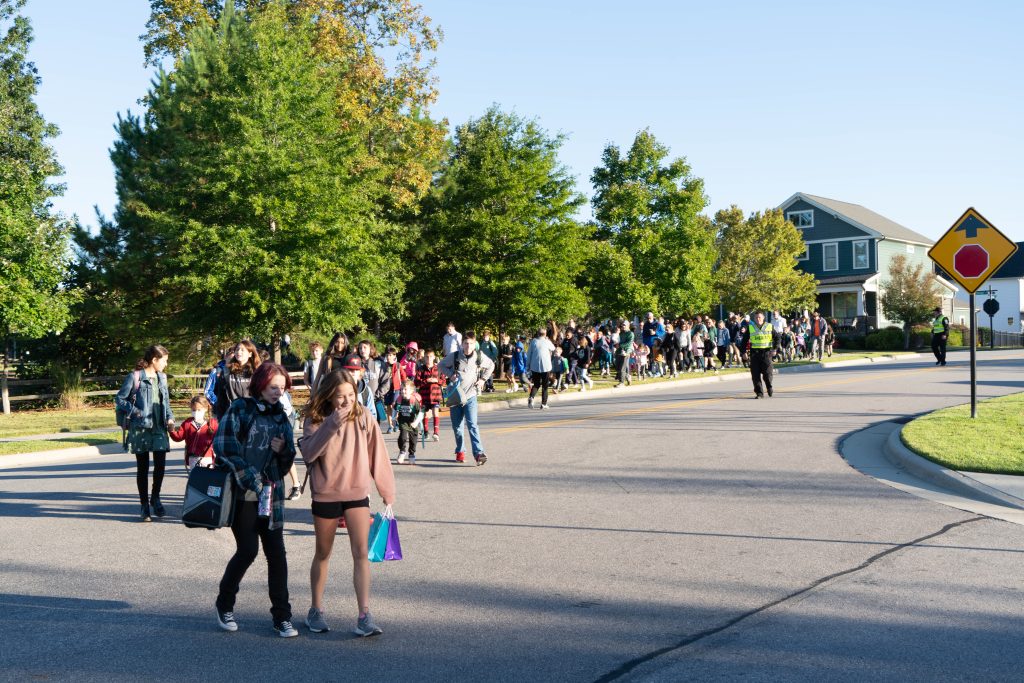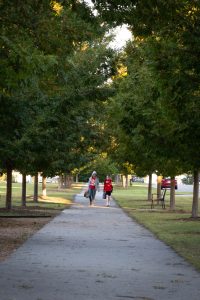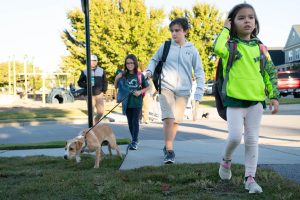As thousands of young students walk, bike, and roll to school for a national event, researchers at the Highway Safety Research Center are searching for ways to combat concerning pandemic driving trends to create safer roadways for everyone.

You’ve heard the saying before: When I was your age, I had to walk (uphill, in the snow, etc.) both ways to school. It’s a comment on how times have changed and a perception that younger generations have it easier in some ways. But for many kids these days, walking to school isn’t even a possibility.
As populations have grown in the U.S., so have roadways and driving infrastructure to meet vehicle transportation needs. Over time, more people have relied on cars to get to their destinations, so less focus has been placed on safe walking and biking routes – creating the unwelcoming environment for people outside of vehicles that exists today. It’s an issue researchers at UNC’s Highway Safety Research Center (HSRC) have been digging into and educating communities about by coordinating events like National Walk and Roll to School Day.
“We know that kids who walk to school show up more ready to learn and engage, and it’s a step in the direction of getting kids the physical activity they need in a day,” says Stephen Heiny, a researcher that works with the National Center for Safe Routes to School within the HSRC.
There are many obstacles preventing kids from walking or rolling to school. Some communities lack sidewalks, bike lanes, and safe crossing areas. Others have sidewalks right next to busy, high-speed roads without any barriers for protection. These obstacles can not only lead to stressful commutes to school, but injuries and fatalities—which have been growing in number during the pandemic.
According to the National Highway Traffic Safety Administration, traffic fatalities reached a 16-year high in 2021, and the following types of fatalities showed significant increases:
- pedestrian by 13%,
- bicyclist by 5%,
- crashes involving at least one large truck by 13%, and
- speeding-related crashes by 5%.

Researchers are looking for causes behind these troubling statistics and point to several pandemic trends that may be partly to blame.
“The number of e-commerce deliveries went up dramatically since the beginning of 2020, which means there are more delivery vehicles on the road,” says Wesley Kumfer, an HSRC researcher with an engineering background focused on traffic safety management. “We also had a substantial drop in traffic volumes early in the pandemic. So, the people who were still driving were able to drive at higher speeds, and even when traffic increased on the roads again, they didn’t slow down to accommodate that change.”
That potentially means there are now bigger vehicles driving faster, which creates greater risk of injury for pedestrians and bicyclists. But those aren’t the only factors at play. Traffic Safety Culture—a collective set of beliefs held by people that inform their road use behaviors and attitudes—has taken a hit from mental health burden. People have experienced loss, stress, and change on a grand scale due to COVID-19 and that could also be translating into less attentive and more aggressive drivers.
Researchers are working quickly to address these negative turns in driving statistics. One way they are doing this is by finding real-world solutions that are seeing positive results.
“We’ve collected a wealth of publicly available data on more than 300 communities across the U.S. and are looking at different characteristics and factors of those that had lower and decreasing counts of pedestrian fatalities,” says Katie Harmon, an HSRC researcher and epidemiologist with a focus on micromobility. “We’re finding that a diverse group of cities in different parts of the country are doing a good job of this. Now we need to figure out how.”
Using data analysis methods and qualitative investigation, along with focus groups and interviews, HSRC researchers, as part of a multi-organizational team, will co-produce a guidebook to share successful practices with other communities and reveal promising strategies for keeping pedestrians safe.
The HSRC has also compiled a report based on academic and government research that aims to improve the public’s understanding of pedestrian and bicyclist behaviors and their relationship to traffic safety. The goal is to create meaningful change by providing legislators, developers, law enforcement, and others with the same set of directions for the clearest path forward.

National Walk and Roll to School Day has a similar goal. The event not only celebrates the act of walking or rolling to class, but also draws attention to areas in a community that need to be addressed before parents can forego the daily carpool lane. If community leaders and decision-makers take a stroll through these neighborhoods, they are getting first-hand experience of how an unfriendly pedestrian environment feels. Heiny has seen improvements spurred by these efforts, which means if roadways and communities are designed to be safe for children, they will be safe for us all.
“By keeping speeds low, having crossing opportunities, having separation of pedestrians and cars, we can create a safer community for children,” Heiny says. “And if a short, small person who behaves erratically will be safe, it will also be safe for a somewhat sensible adult.”
Stephen Heiny is a research associate in the UNC Highway Safety Research Center (HSRC) with a focus on youth active travel safety with the National Center for Safe Routes to School and provides support for Walk and Roll to School Day.
Wesley Kumfer is an engineering research associate in the UNC HSRC with a focus on crash analysis and safety education. He is a member of the Road to Zero Coalition Steering Committee and an instructor for HSRC’s Road Safety Academy.
Katie Harmon is a research associate in the UNC HSRC with a focus on the application of epidemiologic and injury surveillance methods to the prevention of injuries among active transportation users.